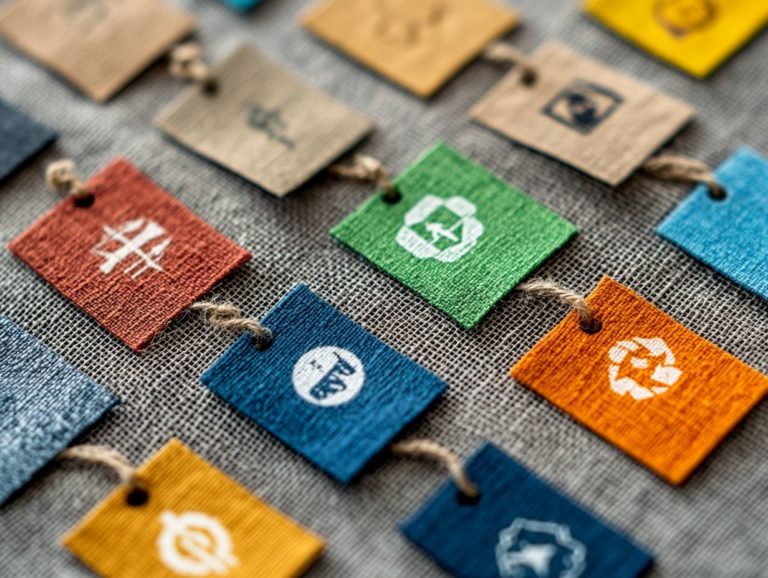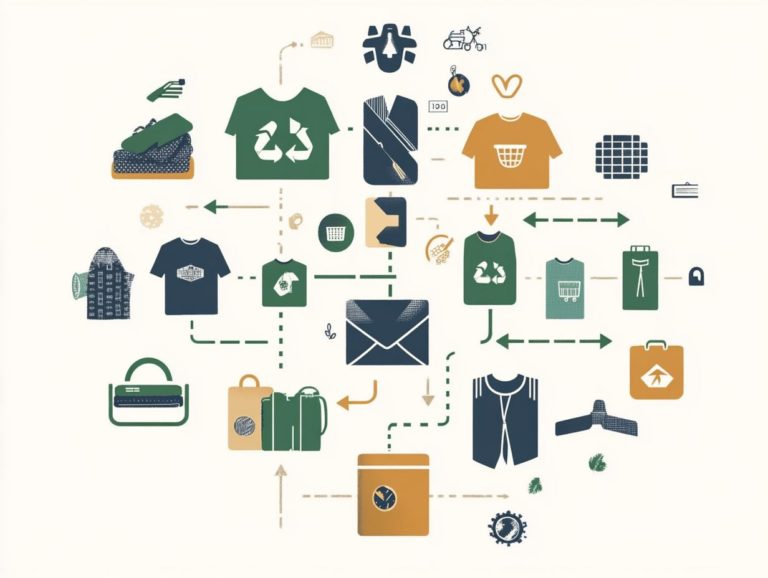The Role of Technology in Sustainable Fashion
Fast fashion, driven by the relentless quest for lower prices, has swept across the globe. However, its environmental impact is a pressing issue as you seek out trendy clothing at lower prices. The industry is under immense pressure to discover sustainable solutions. As you search for stylish options, it’s crucial to recognize the serious concerns surrounding its environmental effects.
Let s explore how fast fashion affects our planet, highlight innovative tech solutions that are reshaping the fashion landscape, and showcase inspiring examples of sustainable practices.
We will discuss the future of sustainable fashion, the challenges that lie ahead, and how you as a conscious consumer can make a meaningful difference.
Dive in with us to uncover the crucial role technology plays in crafting a more sustainable fashion industry.
Contents
- Key Takeaways:
- The Impact of Fast Fashion on the Environment
- How Technology is Changing the Fashion Industry
- Examples of Sustainable Fashion Technology
- The Future of Sustainable Fashion
- Challenges and Limitations of Technology in Sustainable Fashion
- How Consumers Can Support Sustainable Fashion
- Frequently Asked Questions
- 1. What is the role of technology in sustainable fashion?
- 2. How does technology help promote sustainability in the fashion industry?
- 3. Can technology help reduce waste in the fashion industry?
- 4. What are some examples of sustainable technology in the fashion industry?
- 5. How can consumers support the role of technology in sustainable fashion?
- 6. Is technology the only solution for a more sustainable fashion industry?
Key Takeaways:

- Technology is revolutionizing the fashion industry by introducing sustainable materials and improving supply chain management.
- Examples of sustainable fashion technology include recycled and biodegradable fabrics, as well as virtual and augmented reality in fashion.
- As consumers, we can support sustainable fashion by making informed choices and demanding change from brands.
The Impact of Fast Fashion on the Environment
The fast fashion industry has profoundly transformed how you consume clothing, resulting in a notable increase in textile waste and a harmful impact on the environment.
In a landscape where trends shift at lightning speed, you may often feel trapped in a cycle of buying low-quality garments that are quickly discarded after minimal use. This unsustainable behavior not only adds to landfill overflow but also intensifies climate change, making responsible consumption essential for reaching sustainability targets.
As you reflect on the implications of fast fashion, it’s crucial to consider its broader effects on the circular economy an economic system aimed at eliminating waste and the continual use of resources and the pressing need for change.
Environmental Consequences of Fast Fashion
The environmental consequences of fast fashion are significant, leading to considerable textile waste and heightened pollution. This trend results in vast quantities of clothing being discarded annually and contributes to severe water pollution due to the toxic dyes and chemicals employed in production, adversely impacting rivers and ecosystems.
The industry relies heavily on resources that cannot be replaced and emits substantial greenhouse gases from synthetic fibers, exacerbating climate change challenges.
To address these pressing issues, it is essential for you to embrace sustainable practices. By utilizing biodegradable fabrics, you can help reduce waste accumulation. Engaging in innovative recycling initiatives will allow you to reclaim materials, promote a circular economy, and minimize the environmental footprint of your clothing consumption.
How Technology is Changing the Fashion Industry
Technology is fundamentally transforming the fashion industry, addressing enduring challenges like sustainability and supply chain transparency with innovative solutions. As digitalization creates new opportunities, fashion brands are harnessing technology to advocate for responsible consumption and bolster environmental conservation efforts.
This evolution involves adopting blockchain technology, which enhances transparency in sourcing and production processes, enabling you to make informed choices. As technology progresses, it lays the groundwork for a sustainable fashion movement that emphasizes eco-friendly practices and champions groundbreaking solutions.
Join the movement for sustainable fashion today!
Innovations in Sustainable Materials
Innovations in sustainable materials sit at the forefront of the fashion industry’s commitment to reducing environmental impact and championing eco-friendly practices.
Get excited about options like biodegradable fabrics and recycled textiles! Designers are finding innovative ways to lessen their dependence on traditional, harmful materials.
Biodegradable fabrics naturally break down, ensuring their disposal doesn t contribute to landfill overflow. Meanwhile, recycled textiles breathe new life into discarded garments, drastically reducing textile waste.
These groundbreaking materials not only shrink the fashion industry’s ecological footprint. They also usher in a new era of style that places sustainability at the forefront.
As you become more conscious of your purchasing power, it s crucial to embrace these developments now for fostering positive change within the industry.
Advancements in Supply Chain Management

Advancements in supply chain management, driven by technology, are crucial for fostering transparency and accountability in the sustainable fashion industry.
By harnessing modern tools like blockchain a secure way to track information you can carefully track the journey of materials. This ensures that every stage, from raw sourcing to retail, aligns with ethical standards.
This enhanced visibility allows you to show your commitment to sustainability while enabling consumers to make informed choices about their purchases.
Ethical practices are becoming more visible. The importance of transparency is increasingly significant; it forges a bridge of trust between brands and consumers.
This trust promotes responsible consumption, encouraging shoppers to support companies that prioritize integrity and environmental stewardship in their operations.
Examples of Sustainable Fashion Technology
The integration of technology into sustainable fashion has ushered in remarkable innovations, transforming traditional approaches to clothing consumption.
You can see this firsthand in online marketplaces and platforms like Vinted, Poshmark, and Depop, which showcase how technology facilitates the resale of second-hand clothing.
This not only promotes a slower fashion model but also significantly reduces textile waste.
As these technologies continue to evolve, they enhance your awareness as a consumer while contributing meaningfully to the overarching goal of sustainability in the fashion industry.
Recycled and Biodegradable Fabrics
Recycled and biodegradable fabrics represent a remarkable leap in textile innovations, providing you with sustainable alternatives to traditional materials.
These cutting-edge fabrics play an essential role in waste management by reducing your reliance on virgin resources, thereby minimizing the environmental impact linked to fabric production.
By utilizing materials that would otherwise end up in landfills, the fashion industry invites you to engage in a circular economy. This champions the notion that waste can be turned into valuable resources, directly contributing to sustainability campaigns.
As brands increasingly adopt these sustainable textiles, they enhance their ecological credentials, resonating with consumers like you who prioritize environmentally responsible choices.
This transformation not only raises awareness of sustainable practices but also fuels the development of new technologies, ensuring that the fashion industry progresses toward a more sustainable future.
Look for products made from these materials the next time you shop!
Virtual and Augmented Reality in Fashion
Virtual and augmented reality technologies are transforming the way you engage with fashion, enriching your experiences and heightening your awareness of sustainable products.
These innovative applications allow you to dive deep into the story behind each item, grasping its lifecycle from production to purchase.
Brands like Stella McCartney leverage augmented reality to showcase the sustainable materials in their clothing lines, inviting you to explore features and learn about eco-friendly practices.
Companies such as H&M have rolled out virtual fit rooms, letting you visualize how clothing fits and feels while minimizing waste from returns.
By weaving education into these interactive experiences, fashion brands not only captivate your attention but also cultivate a deeper awareness of responsible consumption.
The Future of Sustainable Fashion
The future of sustainable fashion holds immense promise, shaped by evolving expectations and a rising commitment to sustainability. As the fashion industry transitions to a system where products are designed to be reused and recycled, you’ll notice a significant shift toward practices that emphasize environmental conservation and responsible consumption.
Sustainability campaigns are playing a pivotal role in shaping brand strategies. They urge companies to innovate and adapt to cater to the desires of eco-conscious consumers like yourself. This dynamic landscape opens up thrilling possibilities for sustainable fashion brands dedicated to driving positive change.
Predictions and Possibilities

Predictions for sustainable fashion indicate that technology will be instrumental in shaping both consumer awareness and industry practices.
As digital platforms continue to evolve, you’ll find yourself enabled to make informed choices, leading to a greater emphasis on environmentally friendly options. Innovations like blockchain technology will enhance transparency in supply chains, allowing you to trace the origins of your clothing and encouraging the adoption of responsible consumption habits.
Immersive technologies like augmented reality can deepen your engagement by allowing you to visualize the sustainability aspects of products before you commit to a purchase. This fusion of technology and sustainability fosters informed consumption and propels the fashion industry toward innovative practices that aim to reduce its environmental footprint.
Challenges and Limitations of Technology in Sustainable Fashion
Despite the promising advancements in technology within the sustainable fashion sector, you will face challenges that could slow down progress. The complexities of integrating new technologies into existing systems can be daunting. Additionally, the high costs tied to research and development often present significant obstacles for many brands committed to sustainable practices.
Furthermore, consumer skepticism can complicate your efforts to embrace technology-driven solutions in fashion.
Obstacles to Widespread Adoption
Obstacles to the widespread adoption of technology in sustainable fashion include high costs and resistance to change within the industry. These challenges stifle innovative practices and create a disconnect between sustainable options and consumers who may not even know they exist.
High initial investments can easily deter brands from exploring eco-friendly materials or processes, while insufficient information leaves you questioning the value and effectiveness of sustainable choices. There s often a deeply ingrained hesitance among industry leaders to abandon traditional methods, which they view as tried-and-true.
To tackle these issues, targeted educational campaigns are essential for enhancing consumer understanding. The fashion industry could greatly benefit from incentives and collaborations that encourage experimentation with upcycling in sustainable fashion, paving the way for a more inclusive and progressive approach.
How Consumers Can Support Sustainable Fashion
Consumers hold significant power in advancing sustainable fashion through well-considered choices and responsible consumption habits. By choosing high-quality fashion items instead of fast fashion, you contribute to a more robust second-hand economy while minimizing your environmental footprint.
- Engage with sustainable clothing brands.
- Participate in sustainability campaigns.
- Support online marketplaces for pre-loved fashion.
These are all impactful ways you can foster positive change within the industry. Support sustainable brands today to make a difference!
Making Informed Choices and Demanding Change
Making informed choices is crucial for you as a consumer eager to foster change in the sustainable fashion industry. By understanding how your purchases impact the industry, you can influence brand practices and advocate for greater transparency and ethical production.
Prioritizing sustainability drives demand for eco-friendly products. It also inspires companies to rethink how they make and deliver their products. Tools such as mobile apps that evaluate fashion brands based on their sustainability practices, along with online guides and workshops, enable you to make choices that resonate with your values.
Your collective voice, as part of an informed consumer base, can significantly shape the future of fashion. This encourages brands to prioritize ethical commitments in response to the rising awareness and demand.
Frequently Asked Questions

-
1. What is the role of technology in sustainable fashion?
Technology plays a crucial role by providing innovative solutions to reduce the negative impact of the fashion industry on the environment.
-
2. How does technology help promote sustainability in the fashion industry?
Technology promotes sustainability through various methods such as using sustainable materials, implementing sustainable production processes, and creating eco-friendly packaging options.
-
3. Can technology help reduce waste in the fashion industry?
Yes, technology can help reduce waste by utilizing techniques such as 3D printing, which minimizes fabric waste, and implementing automated processes for more precise cutting.
-
4. What are some examples of sustainable technology in the fashion industry?
Examples include biodegradable materials, recycling processes for fabric waste, and renewable energy sources in production facilities.
-
5. How can consumers support the role of technology in sustainable fashion?
Consumers can support this role by purchasing from brands that use sustainable technology, educating themselves on sustainable practices, and advocating for more sustainable industry practices.
-
6. Is technology the only solution for a more sustainable fashion industry?
No, while technology plays a crucial role, other factors like consumer behavior, government regulations, and industry collaboration also contribute significantly to promoting sustainability.
Join the movement towards a sustainable fashion future today! Explore brands that make a difference.






